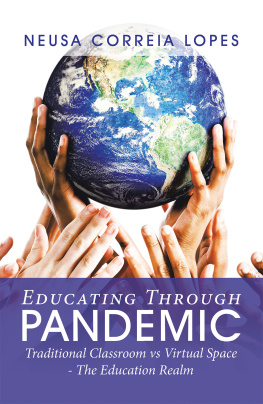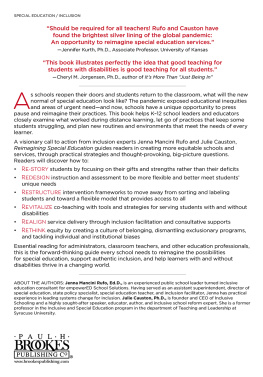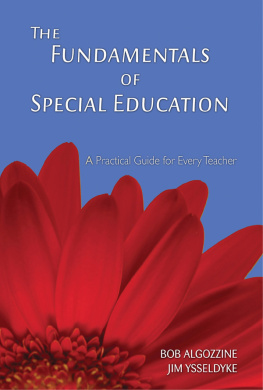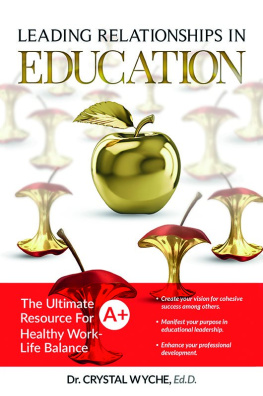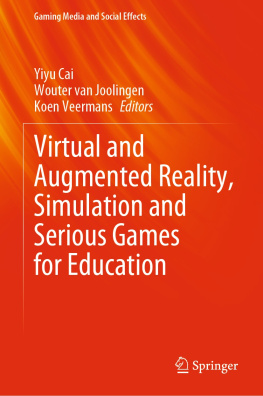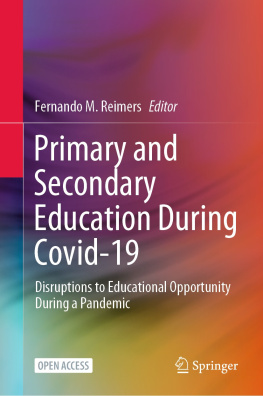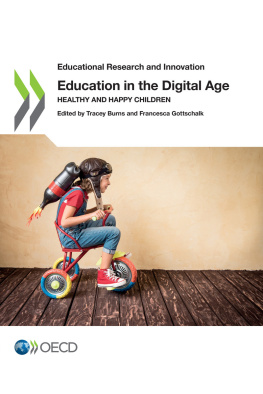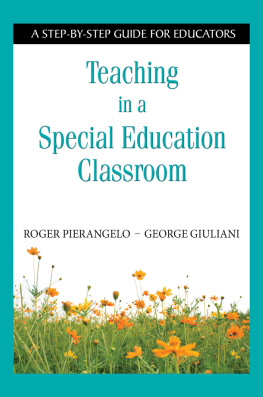EDUCATING THROUGH
PANDEMIC
Traditional Classroom vs Virtual Space
The Education Realm
NEUSA CORREIA LOPES
Copyright 2021 by Neusa Correia Lopes.
Library of Congress Control Number: | 2021907268 |
ISBN: | Hardcover | 978-1-6641-6810-7 |
Softcover | 978-1-6641-6811-4 |
eBook | 978-1-6641-6815-2 |
All rights reserved. No part of this book may be reproduced or transmitted
in any form or by any means, electronic or mechanical, including photocopying,
recording, or by any information storage and retrieval system,
without permission in writing from the copyright owner.
Any people depicted in stock imagery provided by Getty Images are models,
and such images are being used for illustrative purposes only.
Certain stock imagery Getty Images.
Rev. date: 04/16/2021
Xlibris
844-714-8691
www.Xlibris.com
825946
CONTENTS
Neusa Correia Lopes is an educator, a teacher, and an author. She has been in the educational field for more than twenty years. She has been teaching English at secondary schools and universities in Cape Verde. She has also been teaching other linguistics subjects, such as language studies, phonetics, and oral communication. She is now teaching ABE (academic basic English) and ESOL (English for students of other languages) at Bunker Hill Community College, one of the largest community colleges in Massachusetts, USA.
She is also a therapeutic mentor for the Inclusion Family Center in Brockton, Massachusetts, working with families in need of emotional and mental support. She also wrote many articles on culture shock, immigration, culture, and language in A Na o , a Cape Verde newspaper in 20072008. Some of the newspapers traveled in the TACV Cape Verdean airlines for passengers to read. She also published EnigmaPortrait of aLife , an autobiography, in 2020.
To my students, teachers, and educators.
To my children: Christopher, Janet Christina, and Irma Conceio, who are my inspirations. To my granddaughter, Olivia Christina, who will learn the history of this time. To my future grandchildren.
by Jose Henrique Moreno, PhD
Language and culture seem to be crucial factors for individuals. They are important for teachers and educators to value their impact on immigrant students in terms of having a language barrier in the classroom setting, especially now with this new virtual learning process. Obviously, language and culture are intertwined. The inculcation of culture and the English language becomes increasingly challenging in the context of cultural diversity and in moments of adjustment of habitus and social and pedagogical practices. Therefore, associated with the multicultural character and the diversity of the ethnic-cultural origins of the students, the pandemic brought new tasks for the main actors of education. The fact is that the immigrant student has more linguistical and social barriers to overcome in their difficulties, and the teachers and the school have a new opportunity to better serve the community by changing or adapting their practices.
In this book, Neusa Correia Lopes brings several elements for reflectionthe role of culture, namely multiculturalism; the change for the education system; and a new paradigm to build the classroomall of which are fundamental for a better understanding of the teaching-learning phenomenon in the context of the changing process of the educational system brought about by the COVID-19 pandemic.
Consequently, this book is impregnated with long years of her experience as an ESL and ESOL teacher in several contexts and cultures, where she had understood the difficulties of students and teachers. She has analyzed the classroom to comprehend the psychological and emotional impact of the adjustment of culture and the culture of the classroom format. COVID-19 has undoubtedly made an impact on the education world. The multilingual immigrant student population is now challenged by COVID-19 since it demands a lot of social distancing restrictions and health protocols such as mask wearing. Students and teachers must maintain distance and adapt to the new normal way of living. The author stresses in this book some concerns and ways to cope with this new learning process, in which learning and teaching turns out to be difficult.
Neusa Correia Lopes has successfully connected education,
multiculturalism, and the pandemic to show how it is
possible to make the education system more humane and
powerful, making it more open to unpredictability.
The focus on the English language barrier in the classroom setting and how teachers help students overcome this issue in the new normal of COVID-19 had a big impact in the education realm. This book stresses mainly the challenges of the language barrier in the multicultural and multilingual population of students.
A main emphasis of this book is the language barrier in the classroom setting, along with the history of COVID-19 and its impact on education in the world and the USA, including the new classroom setting, the virtual classroom, and the negative and positive aspects of it. I urge teachers/educators to comprehend the background of immigrant students and parents for them to be more effective in teaching these new learners.
I propose strategies on how to explore the language barrier in the classroom setting and the consequences of multiculturalism and the diversity of language spoken in the virtual classroom.
I will focus on the strategies to enhance successful outcomes for students with an English language barrier in the parameters of the pandemic that the world is living now. Also, the approach of the vaccines and hybrid teaching versus learning are mentioned as well.
Aristoteles said, It is in doing that you learn to do what you have to do.
Man cannot learn in virtue of what he knows.
Researchers and language experts believe that the English language is becoming a bigger issue, especially for non-native speakers coming from across the world to establish themselves in the United States. For decades, a huge diversity of immigrants have arrived in the USA, and they encountered several difficulties in the adjustment to the country. The English language proves to be a crucial tool and a factor in their way of living and also modifies their way of behaving. In addition, the English language turns the power of life for most of them. It is also true that in the real world, there was no doubt that the diversity of immigrants created a big impact in ESL (English as a Second Language) and ESOL (English for Speakers of Other Languages) classrooms. Subsequently, with COVID-19, the Unites States, according to the daily news, became a country that had shut the doors of its airports and frontiers for a time. COVID-19 came to determine how classroom settings should adjust to better accommodate new immigrant students with a language barrier. It highlights that the virus came not to determine how teaching should be done in general but to challenge and change the educational system in all aspects. This is done by making major changes and touching many aspects of peoples lives, such as but not limited to emotional, social, psychological, and economic.
The English language barrier has its roots beyond classroom settings. In the traditional classroom, students share one setting and the same physical environment. Teachers do their best to create a positive climate, a relaxing environment in which students would feel free and invited to speak with their native classmates or with those who tend to participate more. This is in contrast to the virtual classroom, where students create their own environment and a classroom can sometimes be more of a mental state for those who cannot afford an office and struggle with distractions, such as a noisy environment caused by parental duties, big shared households, or the Internet itself. In the traditional point of view, the teacher normally has a chance to talk to students directly. How much can physical space satisfy in virtual learning? Virtual learning can give us the opportunity to still do so in a unique way.
Next page
